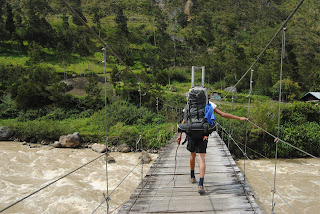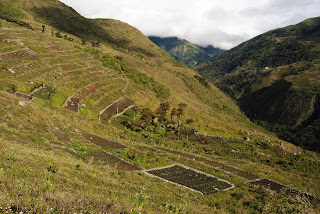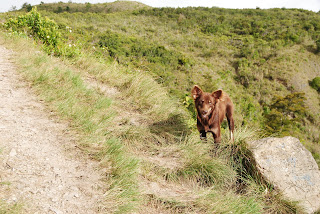There are many guides available to take you trekking into Baliem valley. Make sure that you select a recommended guide to be safe and ensure that you are aware of all the costs up front. Using a tour guide supports the local economy and ensures that you can discover interesting places throughout the valley. However if you fancy a small trek into the valley, the route is fairly simple and you should be able to arrange a small trek on your own. We trekked up to Ugem village on our first day. The second day we visited the next village, Hutugi and could have returned back to Baliem that same day if it didn't rain. We stayed the night in Ugem again, returning back to Wamena the following day following a different, steeper path.
We took an angkot from the market Womar and headed to Yetni River. We then crossed a small river before making our way to a local police station and reporting our visit. Next was this bridge over Baliem River. Not for those scared of some serious rocking motions...There is an old story about the two rivers of Baliem valley, Baliem River and Uweh River. It was believed that there were two snakes, one male and one female. One of the snake’s head got cut off and as the other cried, its tears made the river Baliem (the male snake). Baliem River’s water is always brown with a strong current underneath. Uweh river (the female snake) always has clear water and people use it to shower or wash clothes except when it rains. The two rivers meet on a delta at Gunung Pendosa (Sinner Hill).
A large rock in the valley - the locals believe that if you can throw a pebble up to the top you will be lucky in love.
A view of the valley and various vegetable and sweet potato gardens, separated with rock walls. The main diet of the Dani consists of vegetables and ubi (sweet potato). Vegetables include corn, potato, spinach and keladi. Sweet potatoes can grow very large and they can be roasted in the fire or boiled.
Udang selingkuh (cheating prawn) can also be found in the Baliem river and is served at some of the hotels in Wamena.
A hanoi, the traditional house of the valley. Local houses have plenty of gardens and colourful flowers (a government initiative in Wamena included the planting of flowers along the sides of the roads). Archways are common, made of stacked dry grass. The fences are constructed with chopped wood of irregular size and stacked with grass and dry branches – plants can sometimes be seen growing on top. The hanoi huts were traditionally separated for men and women.
A hanoi rooftop made of hay.
Dogs are commonly found in the valley and are treasured within the household.
Healers in the valley often used plant mixtures to make potions. Some plants used in Wamena valley include daun gatal which was used as massage to provide heat on the skin. Other plants included strong contraceptives which were believed to permanently dry the female’s reproductive system.
Other methods included slitting the wrists, ankles and the temple (in the case of headaches) in order to let out the bad blood. Small arrows would be used to burst out the blood. The medicine man was held highly in the village, but not as highly as the chief.
Here's a scene of Ugem village showing some newly constructed buildings. Development is happening in the valley. The government recently allocated more money to the central mountain districts, however the transportation and price of materials remains a large problem. One sack of cement can cost 1,200,000 IDR in Wamena but 5,000,000 IDR in the Duga village. At the moment, focus is on hospitals and education infrastructures, but in Wamena the city excels – using hydro generators. In faraway villages, diesel generators and solar technology is used. There are no factories apart from a small home-food industry.
Fuel prices are also high in Wamena, (20-25,000 IDR per litre) therefore taxis can be quite expensive. There are many becak drivers (bicycle transportation) who can provide a cheaper way to travel (often around 5,000 IDR for a five/ten minute journey).
There are many NGOs operating in Wamena at present including WWF which are investing eco-tourism options as well as Ekonomos which are providing books as well as education to the children of the valley.
People in the villages often use rainwater or rivers as a source of water and it is difficult to transport sanitation infrastructure such as toilets up to the villages. Showering is therefore quite difficult on any trek into the valley, and discreet trips to a river when no-one is looking are often required...
Here's a photo of a school in Hitugi. Schools in Wamena are mostly funded by BOS (Bantuan Operasional Sekolah) by the government or by NGOs.
There is a saltwater lake in Kurulu (by the Mother Mary cave). There are also salty rocks in Habena lake – suggesting that the valley was an oceanic floor. There are also many marine fossils to be found throughout the valley. This photo of mollusc fossils was found along the pathways between Hitugi and Ugem.
Flowers in the valley. The red flower is a gladiolus. Many orchids can be found in the valley too.
The hanoi houses of Ugem village.
Children in the village, keen to say hello and have a look at their photo.
The valley in the afternoon, on our way back down to the bridge. Hope you enjoyed our little account of stories and tales from the very secretive and lush valley of Baliem.



















No comments:
Post a Comment